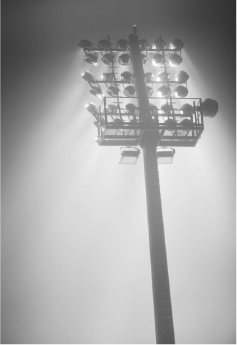
Let there be light, decreed the International Cricket Council in July 1997, and lo and behold, four months later there was in Test cricket – in Perth, of all places, in the second Test between Australia and New Zealand.
On the final session of the second day’s play, the lights came on and Mark Waugh basked in the spotlights, driving Kiwi spinner Daniel Vettori on to the roof of the five-tier Lillee–Marsh Stand. It was, declared local old-timers, probably the biggest six that the WACA had seen.
As Wisden later noted, in a decade in which Test cricket was struggling in several countries ‘to justify its existence as a commercial entity, the advent of Tests with supper intervals cannot be far away’.

In fact floodlights first came to cricket twenty years earlier, during a World Series match in Victoria in December 1977 between the World XI and Australia. John Woodcock of The Times sniffed that it was OK for Australians, what with them ‘being always early with their evening meal’. Others were less dismissive. Alan Lee predicted that the concept would ‘arouse the envy of the traditional authorities’.
It aroused only their indifference. As Rob Steen explained in an essay for the 1998 edition of Wisden: ‘State funds provided pylons in Brisbane and Perth. English concessions to all this garish modernity were hesitant and fleeting.’ India, on the other hand, pumped money from the 1996 World Cup it had hosted into installing floodlights at its major stadiums. Some English counties were more enthusiastic than others; Edgbaston hoisted some temporary lights within days of the ICC’s ruling in 1997, and 15,174 spectators came to see Warwickshire play Somerset in a Sunday league match.

The traditionalists were mortified
But what held back the English was their fear of the weather. Floodlit cricket was suitable for Australia and the subcontinent, but not in Blighty, surely, where even in the summer sun a chill dampness lingers?
But as attendances for county matches continued to drop and the ECB searched around desperately for a way to bring back the fans (which ultimately would lead to Twenty20), so an acceptance seeped into the MCC that Lord’s would have to move with the times. The traditionalists were mortified. Writing in the Daily Mail, Ian Woolridge shed tears of anguish which practically dripped on to the page as he informed readers that ‘radical proposals [are] now under consideration to transform this historic territory into a pop venue or theme park’.
Temporary floodlights were installed at Lord’s in 2007, and then in 2009 – after protracted negotiations with local residents, who threatened legal action if there was a ‘visual intrusion’ – work began to erect a set of permanent lights. They are state-of-the-art, retractable telescopic lights that are raised from their lower level of 97 feet up to 157 feet 6 inches by a hydraulic ram.
The floodlights were an immediate success, seeing the light of night for the first time on 27 May in a Twenty20 match between Middlesex and Kent.
Encouraged by the commercial success of floodlit cricket, the ICC announced in October 2012 that in the future countries will be permitted to schedule day–night Tests. ‘Bring it on!’ exclaimed former Australian wicketkeeper Rodney Marsh, a recent addition to the MCC’s world cricket committee. ‘People need to understand that during World Series Cricket we played Super Tests at night,’ he added. ‘There is no reason why this can’t happen with Test matches today.’
What would need to change in order to accommodate Test cricket at night is the colour of the ball. Red would be impossible to see, agreed Marsh, who suggested they ‘could use a red ball in the day time and white clothing, and then change to colours and a white ball in the evening session’.
But Marsh acknowledges that for such an innovation to happen the ICC will have to be ‘courageous’. Or, to put it another way, they’ll have to show balls.